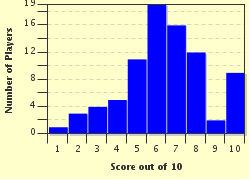Quiz Answer Key and Fun Facts
1. One of the most basic statistics an epidemiologist looks at is called the basic reproduction number or R nought. What can this number tell us?
2. Which of these diseases has the highest basic reproduction number? In other words, which of these has the highest rate of transmission?
3. Which one of these measurements refers to the proportion of infected individuals in a population at any given time?
4. An epidemiologist only studies infectious diseases.
5. What is meant when a disease is said to be endemic?
6. You heard on the news that the incubation period for Ebola is 2-21 days. What exactly is an incubation period?
7. The determinants of a disease can be either intrinsic or extrinsic. Which of these would be considered an intrinsic determinant?
8. Why is a global pandemic much more likely today than it was centuries ago, despite all of our medical advances?
9. What are the three components of the epidemiological triad?
10. Epidemiology is considered to be a branch of public health. How is this different from the study of medicine?
Source: Author
kufan888
This quiz was reviewed by FunTrivia editor
WesleyCrusher before going online.
Any errors found in FunTrivia content are routinely corrected through our feedback system.

